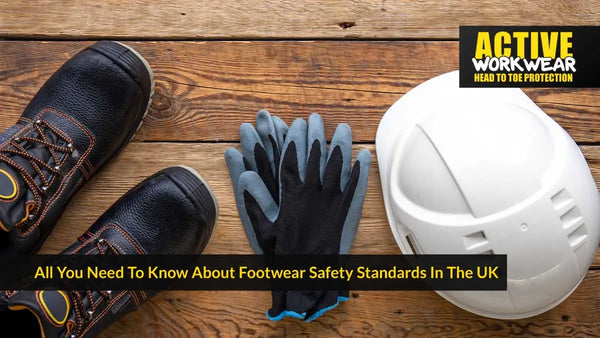All You Need To Know About Footwear Safety Standards In The UK
- by Mike Johnson

All You Need To Know About Footwear Safety Standards In The UK
Keeping your feet safe and comfortable is an important part of taking care of yourself - and it's even more important if you work in certain industries. In this article, we'll explore the different footwear safety standards in the UK and how they help protect workers from potential injuries. Read on to find out more about how you can protect yourself from workplace hazards!
Introduction to Safety Footwear Standards in the UK
There are a number of different footwear safety standards in the UK, all of which are designed to protect wearers from potential risks. The most common standards are the British Standard BS EN ISO 20345 and the European Standard EN ISO 20346.
BS EN ISO 20345 is the standard for safety footwear in the UK and covers a wide range of footwear, including shoes, boots and sandals. It sets out minimum requirements for toe protection, slip resistance, energy absorption and more.
Identify the shoes and boots you need to wear in the workplace according to the safety footwear standards. Every employer should make sure that any employees who might be exposed to health and safety risks are provided with suitable personal protective equipment (PPE) - but only if every attempt to mitigate, control or eliminate the hazard or risk has first been attempted.
EN ISO 20346 is the European standard for safety footwear and covers a similar range of products to BS EN ISO 20345. However, it has different requirements for protection and slip resistance.
Both standards are widely recognised and used in the UK, so you can be confident that any safety footwear you buy will meet minimum standards for safety.
Overview of the Statutory Requirements for Footwear Manufacturers in the UK
In the UK, there are several statutory requirements that footwear manufacturers must comply with to ensure the safety of their products. These requirements are set out in the following legislation:
The Consumer Protection Act 1987 - This act provides for consumers' safety when using products manufactured or supplied by businesses. It requires businesses to take all reasonable steps to ensure that their products are safe for consumers to use.
The General Product Safety Regulations 2005 - These regulations implement the provisions of the Consumer Protection Act 1987 about general product safety. They place a duty on manufacturers and importers of products to ensure that they are safe before they are placed on the market.
The Personal Protective Equipment (EC Directive) Regulations 1992 - These regulations implement the European Directive on Personal Protective Equipment requirements in relation to footwear intended to protect against risks arising from physical, electrical or chemical hazards.
In order to comply with these statutory requirements, manufacturers must take all reasonable steps to ensure that their products are safe for consumers to use. This includes ensuring that products are designed and manufactured to meet relevant safety standards and that adequate warnings and instructions are provided with products where necessary.
Types of Footwear and Their Respective Safety Standards
There are several types of footwear, each with its own safety standard. Here is a brief overview of the most common types of footwear and their respective safety standards:
1. Safety Boots - These boots are designed to protect your feet from a variety of hazards, including sharp objects, electrical currents, extreme temperatures, and chemicals. They must meet stringent safety standards set by the UK government in order to be sold legally.
2. Safety Shoes - These shoes are not as heavy-duty as safety boots, but they still offer some protection from hazards such as sharp objects and electrical currents. They must meet certain safety standards set by the UK government in order to be sold legally.
3. Protective Footwear - This type of footwear includes a variety of items, such as steel-toe boots, toe guards, and metatarsal guards. They are designed to protect your feet from impact and compression injuries. Some protective footwear must meet certain safety standards set by the UK government in order to be sold legally.
4. Slip-Resistant Footwear - This type of footwear is designed to help prevent slips and falls on wet or oily surfaces. It usually has a special sole with grooves or treads that help grip the floor better. Slip-resistant footwear must meet certain safety standards set by the UK government in order to be sold legally.
What Types of Tests Are Required for Shoes?
There are several different types of tests that are required for shoes in order to ensure their safety. These tests include:
- Abrasion resistance testing: This type of test is used to determine the ability of a shoe to withstand wear and tear.
- Impact resistance testing: This test is used to evaluate a shoe's ability to absorb impact and protect the foot from injury.
- Slip resistance testing: This test is conducted to assess a shoe's ability to provide traction and prevent slips and falls.
How to Ensure Compliance with These Regulations?
In order to ensure compliance with the UK's footwear safety standards, it is important to take a few key steps.
First, be sure to purchase your shoes from a reputable source.
Second, check the label on the shoe to make sure it meets the EU standard for personal protective equipment (PPE).
Third, wear your shoes according to the manufacturer's instructions and only use them for their intended purpose.
Finally, regularly inspect your shoes for signs of wear and tear and replace them when necessary. By following these simple tips, you can help ensure that your feet are always protected while you're on the job.
Benefits of Adhering to Safety Standards in the UK
There are many benefits to adhering to safety standards in the UK. Perhaps the most important benefit is that it helps protect workers from injury.
According to the Health and Safety Executive, there were over 500,000 workplace injuries in the UK in 2017/18. Of these, around 20,000 were serious enough to result in an employee taking time off work.
Adhering to safety standards can also help businesses avoid costly fines and other penalties. The Health and Safety at Work etc. Act 1974 imposes strict liability on employers for the health and safety of their employees. This means that if an employee is injured as a result of a breach of health and safety regulations, the employer can be held liable regardless of whether they were negligent or not.
Finally, complying with safety standards sends a positive message to employees, customers and other stakeholders that your business takes health and safety seriously. This can help boost morale and improve your reputation.
Conclusion - All You Need To Know About Footwear Safety Standards In The UK
Footwear safety standards in the UK are set to ensure that shoes provide adequate protection and comfort for the wearer. It is important to consider these regulations when purchasing footwear, as any footwear without a CE mark or that does not meet minimum requirements will be deemed unsafe and could lead to serious injury.
We hope this article has provided you with an overview of all you need to know about footwear safety standards in the UK, so you can make safe and informed decisions when buying your next pair of shoes.
- Posted in:
- safety boots





